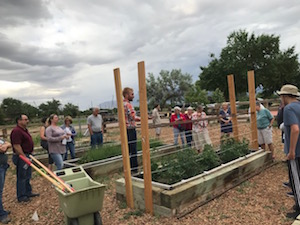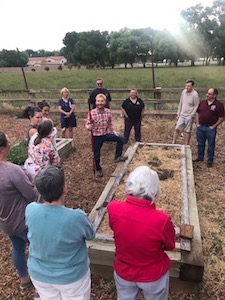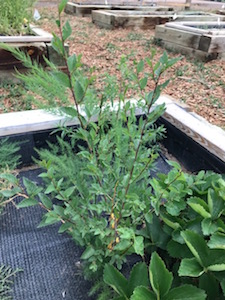 Bernalillo County Cooperative Extension Agriculture Agent John Garlisch leads a “Summer Raised Bed Gardening” workshop in Albuquerque the first week of June. Photo credit M. Thompson.Questions: Why do people build raised beds? Why not just plant directly in the soil? What’s the recommended height for a raised garden bed? Am I ruining everything by overcrowding my poor plants? What if my raised bed was ready, but I was too late to plant?
Bernalillo County Cooperative Extension Agriculture Agent John Garlisch leads a “Summer Raised Bed Gardening” workshop in Albuquerque the first week of June. Photo credit M. Thompson.Questions: Why do people build raised beds? Why not just plant directly in the soil? What’s the recommended height for a raised garden bed? Am I ruining everything by overcrowding my poor plants? What if my raised bed was ready, but I was too late to plant?
 Attendees of the “Summer Raised Bed Gardening” Workshop at the Larry P. Abraham Agri-Nature Center in Los Ranchos de Albuquerque, hosted by Bernalillo County Cooperative Extension Agriculture Agent John GarlischAnswers: Last week I attended this Albuquerque workshop on raised bed gardening and took copious notes, both of the questions posed by attendees and the answers provided by our instructor, John Garlisch, NMSU Extension Agriculture Agent for Bernalillo County. We had a lot of fun, partly because the class was in a beautiful valley setting alongside a young vineyard and because a soft rain fell – twice.
Attendees of the “Summer Raised Bed Gardening” Workshop at the Larry P. Abraham Agri-Nature Center in Los Ranchos de Albuquerque, hosted by Bernalillo County Cooperative Extension Agriculture Agent John GarlischAnswers: Last week I attended this Albuquerque workshop on raised bed gardening and took copious notes, both of the questions posed by attendees and the answers provided by our instructor, John Garlisch, NMSU Extension Agriculture Agent for Bernalillo County. We had a lot of fun, partly because the class was in a beautiful valley setting alongside a young vineyard and because a soft rain fell – twice.
Here are a few good reasons to try raised beds in your yard: you have difficulty or pain when reaching over to tend a garden on the ground, you want to keep rabbits or other critters out, the available area is covered with a hardscape like asphalt or bricks, you want to garden on your patio or balcony, or you’ve had it up to here with weeds.
The weeds reason, specifically Bermudagrass, was what prompted us to try raised beds in our Las Cruces yard several years ago. Attempts at controlling that persistent, perennial Poaceae included thick, expensive black plastic lining in one bed, several layers of recycled cardboard in another, and a third bed that was meticulously hand-tilled and devoided of the large, grotesque root clusters. The black plastic liner worked (kind of), at least in the short term. After filling with store-bought soil, the lining held water, making a soupy sludge. Roots need oxygen, so we had to puncture holes through the bottom for drainage. That worked for a season, but by the time the Bermudagrass found the holes it was raring to grow and did so exceptionally fast in the well-watered, fancy soil. Weeds ripped through the cardboard layers in bed number two like the raised bed was a slice of tiramisu. And bed number three never stood a chance. As soon as the fluffy 8 ft by 8 ft area was tilled free of Bermudagrass roots, which was no small task and one that I managed to dodge completely – you have to be smart to be lazy! -- fresh lines of drip tape were strategically placed with emitters within reach of carefully planted okra and tomatillo seeds. We left for two weeks of vacation and returned to an 8 ft by 8 ft square of bright green, 2-ft tall Bermudagrass. The okra and tomatillo sprouted, but barely, since the grass hogged all the sunlight. In the end, losing the battle and hating the weeds was too stressful, so we kept them in check by weed-whacking and just came to terms with having a “Garden of Weeden.” But there is hope. Finely woven hardware cloth (a metal screen) as a secured bottom liner has helped many a raised bed stay predominantly weed-free and can deter tunneling critters as well.
 A Siberian elm seed that blew in this spring had no trouble putting down roots at the base of this strawberry plant. Mulch probably wouldn’t have helped in this case; the only cure is diligence, aka work.. Photo credit M. Thompson.Of course, weed seeds, like those from Siberian elms, may also jump right into bed with your veggies from the undefended top, and if it’s not tall enough, so can hungry critters. When asked the recommended height for keeping rabbits out, John pointed out that it depends on the rabbit. A few feet off the ground will help, and remember that if it’s a high raised bed, the soil doesn’t have to be super deep. Many herbs only require a minimum of 12 inches or so of soil, although a little deeper is better for healthy root systems and moisture retention. Plants with more robust rooting needs, like carrots and parsnips, need closer to 18 or 24 inches of soil depth, respectively. John also cautioned gardeners to think ahead about how tall their crops are expected to get and how high their beds are. I appreciate this type of advice. Leave it to me to plant corn in a waist-high planter and need a ladder to harvest it! For recommended vegetable varieties and details on how and when to plant and harvest them, access the NMSU Extension Circulars 457 “Home Vegetable Gardening in New Mexico,” 457B “Growing Zones, Recommended Crop Varieties, and Planting and Harvesting Information for Home Vegetable Gardens in New Mexico,” and Guide H-216 “When to Harvest Vegetables” by searching publications online at https://aces.nmsu.edu/pubs/.
A Siberian elm seed that blew in this spring had no trouble putting down roots at the base of this strawberry plant. Mulch probably wouldn’t have helped in this case; the only cure is diligence, aka work.. Photo credit M. Thompson.Of course, weed seeds, like those from Siberian elms, may also jump right into bed with your veggies from the undefended top, and if it’s not tall enough, so can hungry critters. When asked the recommended height for keeping rabbits out, John pointed out that it depends on the rabbit. A few feet off the ground will help, and remember that if it’s a high raised bed, the soil doesn’t have to be super deep. Many herbs only require a minimum of 12 inches or so of soil, although a little deeper is better for healthy root systems and moisture retention. Plants with more robust rooting needs, like carrots and parsnips, need closer to 18 or 24 inches of soil depth, respectively. John also cautioned gardeners to think ahead about how tall their crops are expected to get and how high their beds are. I appreciate this type of advice. Leave it to me to plant corn in a waist-high planter and need a ladder to harvest it! For recommended vegetable varieties and details on how and when to plant and harvest them, access the NMSU Extension Circulars 457 “Home Vegetable Gardening in New Mexico,” 457B “Growing Zones, Recommended Crop Varieties, and Planting and Harvesting Information for Home Vegetable Gardens in New Mexico,” and Guide H-216 “When to Harvest Vegetables” by searching publications online at https://aces.nmsu.edu/pubs/.
When asked what to do about overcrowding, John urged not to be timid – thin your plants so each has a decent amount of rooting area and sunlight or you might risk losing more than you would have thinned. And when one gardener lamented, “What should I do with a prepped garden bed that I don’t have time to plant this summer,” John recommended bed rest with a thick blanket of straw or leafy mulch so it’ll be ready when you are. Check back next week for answers to more raised bed and vegetable gardening questions like What time of day should I water?, Why is water pooling on the soil surface?, and When is the right time to pull garlic?
Send gardening questions to Southwest Yard and Garden - Attn: Dr. Marisa Thompson at desertblooms@nmsu.edu
Please copy your County Extension Agent and indicate your county of residence when you submit your question!
For more gardening information, visit the NMSU Extension Horticulture page at Desert Blooms.